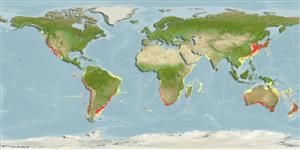Classification / Names
Common names from other countries
Main reference
Size / Weight / Age
Max length : 300 cm TL male/unsexed; (Ref. 5578); common length : 150 cm TL male/unsexed; (Ref. 6077); max. published weight: 107.0 kg (Ref. 9987); max. reported age: 49 years (Ref. 27952)
Length at first maturity
Lm ?, range 192 - 208 cm
Environment
Marine; brackish; demersal; depth range 0 - 570 m (Ref. 26346), usually ? - 80 m (Ref. 5578)
Climate / Range
Subtropical, preferred 17°C (Ref. 107945); 56°N - 55°S, 131°W - 177°E (Ref. 54680)
Distribution
Circumglobal: In tropical to temperate waters; except North Atlantic and Mediterranean Sea. Southwest Atlantic: southern Brazil to northern Argentina. Southeast Atlantic: Namibia to East London, South Africa (Ref. 5578). Western Pacific: southern Japan to New Zealand. Eastern Pacific: British Columbia, Canada to Chile. Record from India maybe erroneous.
Countries | FAO areas | Ecosystems | Occurrences | Introductions
Short description
Dorsal
spines
(total): 0;
Dorsal
soft rays
(total): 0;
Anal
spines: 0;
Anal
soft rays: 0;
Vertebrae: 123 - 157. A large seven-gilled cowshark (Ref. 5578) with a wide head, short and blunt snout, and fusiform body. Dorsal fin small, origin may vary from over insertion of pelvic fins to over free rear tips of pelvic fins. Anal fin smaller than dorsal fin. Tooth count 15-16/13. Reddish-brown to silvery-grey or olive-brown with numerous small black spots on body and fins; cream below (Ref. 5578).
IUCN Red List Status (Ref. 115185)
Human uses
Fisheries: commercial; gamefish: yes; aquarium: public aquariums
Tools
Special reports
Download XML
Internet sources
Estimates of some properties based on models
Phylogenetic diversity index
PD50 = 1.0781 many relatives (e.g. carps) 0.5 - 2.0 few relatives (e.g. lungfishes)
Trophic Level
4.7 ±0.2 se; Based on diet studies.
Resilience
Very Low, minimum population doubling time more than 14 years (rm=0.026; K=0.25; tm=16; tmax=32; Fec=82-95)
Vulnerability
High vulnerability (57 of 100)
Price category
